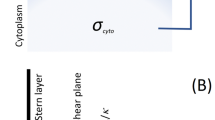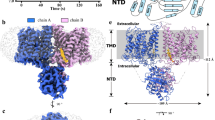Abstract
THE divalent cation-selective ionophore A23187 is known to form complexes with monovalent cations1, but it is not clear whether such complexes actually translocate across biological membranes. In the absence of Ca and Mg, the ionophore can transport K across the mitochondrial membrane in a manner reminiscent of the nigericin class of ionophores2. From spectrofluorometric and bulk organic phase partition data3, Pfeiffer and Lardy concluded that Na binds to the ionophore better than K (Li > > Na > K ≃ O) and it is surprising that no observations of this Na form of the ionophore crossing biological membranes have been reported. We have used a recently developed method3 designed to study the effect of intracellular Mg on the various ion fluxes mediated by the Na pump, and we report here that intact human red cells incubated in buffered isotonic NaCl media containing EDTA, no added divalent cations and the ionophore A23187, gain Na and swell. This effect was not accompanied by any change in the K permeability and could be prevented or reversed by adding Mg or Ca to the medium. Thus, in certain conditions A23187 may indeed mediate Na transport.
This is a preview of subscription content, access via your institution
Access options
Subscribe to this journal
Receive 51 print issues and online access
$199.00 per year
only $3.90 per issue
Buy this article
- Purchase on Springer Link
- Instant access to full article PDF
Prices may be subject to local taxes which are calculated during checkout
Similar content being viewed by others
References
Pfeiffer, D. R., Reed, P. W. & Lardy, H. A. Biochemistry 13, 4007–4014 (1974).
Pfeiffer, D. R. & Lardy, H. A. Biochemistry 15, 935–943 (1976).
Flatman, P. & Lew, V. L. Nature 267, 360–362 (1977).
Gardos, G. Biochim. biophys. Acta 30, 653–654 (1958).
Lew, V. L. & Ferreira, H. G. Nature 263, 336–338 (1971).
Bodemann, H. H. & Hoffman, J. F. J. gen. Physiol. 67, 547–561 (1976).
Beaugé, L. Biochim. biophys. Acta 401, 95–108 (1975).
Hoffman, J. F. & Kregenow, F. M. Ann. N. Y. Acad. Sci. 137, 566 (1966).
Beaugé, L. & Ortiz, O. J. Membr. Biol. 13, 165–185 (1973).
Sachs, J. R. J. gen. Physiol. 57, 259–282 (1971).
Lew, V. L. & Beaugé, L. in Transport Across Biological Membranes (eds Giebisch, G., Tosteson, D. C. & Ussing, H. H.) vol. 2 (Springer, in the press).
Proverbio, F. M., Condrescu-Guidi & Whittembury, G. Biochim. biophys. Acta 394, 281–292 (1975).
Sarkadi, B., Szasz, L. & Gardos, G. J. Membr. Biol. 26, 357–370 (1976).
Author information
Authors and Affiliations
Rights and permissions
About this article
Cite this article
FLATMAN, P., LEW, V. Does ionophore A23187 mediate Na transport in the absence of divalent cations?. Nature 270, 444–445 (1977). https://doi.org/10.1038/270444a0
Received:
Accepted:
Issue Date:
DOI: https://doi.org/10.1038/270444a0
This article is cited by
-
K+-evoked taurine efflux from cerebellar astrocytes: On the roles of Ca2+ and Na+
Neurochemical Research (1989)
-
Effect of metabolic depletion on the furosemide-sensitive Na and K fluxes in human red cells
The Journal of Membrane Biology (1985)
-
Magnesium transport across cell membranes
The Journal of Membrane Biology (1984)
Comments
By submitting a comment you agree to abide by our Terms and Community Guidelines. If you find something abusive or that does not comply with our terms or guidelines please flag it as inappropriate.



